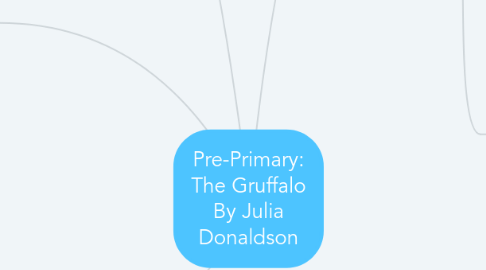
1. Maths
1.1. Measuring Activity: Students will measure the footprints of the animals that they left around the classroom. The students will use 1cm metric cubes. The footprints will be set in flour, so the children can vividly see what they are measuring.
1.1.1. Make the animals feet, using boxes, tape, pipe cleaners etc and made to the exact size of what they have measured in their investigation.
1.2. Students will encounter a Maths Trail. Outside they will have to follow the Gruffalo's feet, to find the recipe to Making Gruffalo Crumble.
1.2.1. Students will create Gruffalo Crumble
1.2.2. You will need: 5 bananas (peeled and sliced thickly) 350g frozen (or fresh) berries (I used mixed red berries) 250g cookie crumbs (I used plain digestives smashed up, but graham crumbs would work; I think gingersnaps would be good to try, too!) 140g brown sugar 1/4 tsp cinnamon 140g melted butter
2. Science
2.1. Create an Imaginary creature and write a report on it. Students will need to consider What does it eat? Where does it live? How is it adapted to live in that place?
2.1.1. This can be extended by creating a Book Creator of their report, this way they can use voice-overs to create their report on their imaginative creature
2.2. Food Chain: The educator and the students will create the Food chain that is seen in the book. This will be done on the smartboard where the students can move the animals around and physically see the chain.
2.2.1. This will be extended into the students creating their own food chain for their own animal. It will be a five level food chain, with their animal either at the top of the food chain or the bottom (they'll use their imagination and will explain why they have place their creature, where it is).
2.3. Students will discuss the about the animals homes. Students will discuss about the habitats and create one best suited to their imaginary creature. This will stuck on the wall to show everyone their habitat. Students will draw their creature and make part of the wall, their creatures home.
3. The Arts
3.1. Performing Arts
3.1.1. Gruffalo Play: Students will create their own script to perform to the class. The students will have materials, that have been gather throughout all the learning areas; such as, Using The Gruffalo cafe, using masks and the making of other props and costumes.
3.2. Students will create their own imaginary creatures. They will need to consider, the height, colour and other physical features.
3.2.1. This links to the English learning area as they discuss what animals are used to make the imaginative Gruffalo.
3.2.2. Technologies: Students will design their Imaginary creature through Switchzoo. This will allow them to easily understand what their creature looks like. As well as implementing the technologies into the curriculum.
4. English
4.1. Literacy
4.1.1. Identify some features of texts including events and characters and retell events from a text (ACELT1578)
4.1.1.1. Character Profile: Students will create character profile of the Gruffalo. Students will include the Gruffalo's favourite food, what it looks like, where it lives and what type of personality does the Gruffalo have.
4.1.2. Innovate on familiar texts through play (ACELT1831)
4.1.2.1. Gruffalo Cafe: A realistic play centre of a cafe, that provides students to make Gruffalo food, and to sell and serve it to their customers. Students will create their own menu's and layout of cafe.
4.1.3. Identify some differences between imaginative and informative texts (ACELY1648)
4.1.3.1. Students will describe the Gruffalo (this will ink to the science lesson). They will discuss the closest animals they think the Gruffalo is made of. (Maybe a bear or a Kimono dragon). Within their group they will make a Pic Collage of animals that make the imaginary Gruffalo.
4.2. Language
4.2.1. Recognise and generate rhyming words, alliteration patterns, syllables and sounds (phonemes) in spoken words (ACELA1439)
4.2.1.1. Matching Rhyming Pairs: Students will put the cards face down on the table. One student turns her two cards. If they rhyme they are a matching pair. If they do not match, students will turn the cards back over and next participant will go. Continue till all the cards have a matching pair.
4.2.2. Use interaction skills including listening while others speak, using appropriate voice levels, articulation and body language, gestures and eye contact (ACELY1784)
4.2.2.1. The educator whilst reading the story will enter the scene through a playful approach, Using finger puppets, they will tell the story using props, scenes to describe what is happening. The educator must over exaggerate what they are talking and pause to show reading strategies.
4.2.3. Recognise that sentences are key units for expressing ideas (ACELA1435)
4.2.3.1. Students will create a WANTED poster for the Gruffalo. They will use their describing words to encourage their idea and whom they are trying to find. They must post it around the classroom, so everyone can see whom is WANTED.
4.3. Literature
4.3.1. Use comprehension strategies to understand and discuss texts listened to, viewed or read independently (ACELY1650)
4.3.1.1. Gruffalo Story Stones: Students will engage in the story stones through expressing their comprehension of the book. Educator will have the characters printed and stuck to each stone.
4.3.2. Use comprehension strategies to build literal and inferred meaning about key events, ideas and information in texts that they listen to, view and read by drawing on growing knowledge of context, text structures and language features (ACELY1660)
4.3.2.1. Shared Reading: The Gruffalo will focus on describing words and the students will practice the strategy of sounding out. They will sound out the describing word. Some predicting will come into it, when stuck.

